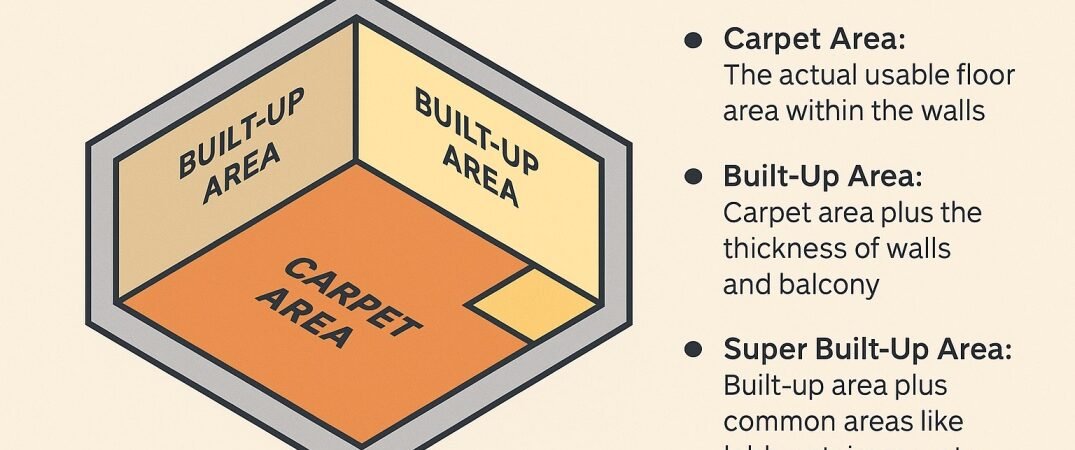When you’re buying a property in India, one of the most confusing parts of the process is understanding how area is calculated.
Builders often quote different types of area — and unless you know the difference between carpet area, built-up area, and super built-up area, you might end up paying more than you should.
In this blog, we’ll break it down with legal definitions, practical examples, and RERA-compliant explanations to help you make informed decisions.
🧱 1. What Is Carpet Area?
Carpet area is the actual usable floor area within the walls of your apartment — the area where you can literally lay a carpet.
According to Section 2(k) of the RERA Act, 2016, carpet area is:
“The net usable floor area of an apartment, excluding the area covered by the external walls, areas under services shafts, exclusive balcony or verandah area, and exclusive open terrace area, but includes the area covered by the internal partition walls of the apartment.”
✅ What Carpet Area Includes:
- Bedroom
- Living room
- Kitchen
- Bathrooms
- Internal walls
❌ What Carpet Area Does NOT Include:
- External walls
- Balcony/veranda
- Utility ducts
- Common areas
- Shaft spaces
In RERA-registered projects, builders are legally bound to quote the carpet area only while advertising or selling.
🧱 2. What Is Built-Up Area?
Built-up area is the carpet area plus the thickness of walls and the area of balconies.
It gives a more realistic measure of the space you’ll own, but not necessarily use entirely.
✅ What Built-Up Area Includes:
- Carpet area
- Internal & external walls
- Dry balcony or utility areas
🧮 General Thumb Rule:
Built-up area = Carpet Area + 20% (approx.)
Builders may try to sell using built-up area to make the flat seem larger than it actually is.
But under RERA, this is discouraged.
🧱 3. What Is Super Built-Up Area?
Super built-up area is the built-up area plus a proportionate share of common areas like:
- Lobby
- Lift shafts
- Staircases
- Gym, clubhouse
- Garden, pool (if applicable)
- Corridor and reception areas
This is sometimes referred to as the “saleable area” — which is problematic because you pay for space you don’t own privately.
🧮 Formula:
Super Built-Up Area = Built-Up Area + Proportionate Common Area
⚖️ 4. What Does the Law Say?
Under the Real Estate (Regulation and Development) Act, 2016 (RERA):
- Builders are prohibited from advertising based on built-up or super built-up area
- Only carpet area must be mentioned in agreements and promotional materials
- Buyers must receive detailed area breakups before booking
- Section 4 of RERA mandates submission of carpet area and sale area details during project registration
This helps prevent misrepresentation and inflated pricing.
📌 5. Why This Matters to Buyers
Here’s how these area types affect your purchase:
| Metric | Impact |
| Carpet Area | Determines usable living space |
| Built-Up Area | Often used in builder quotes (less accurate) |
| Super Built-Up Area | Can artificially inflate per sq. ft. price |
Let’s say a builder quotes ₹10,000/sq. ft. on a 1,000 sq. ft. super built-up area.
If the actual carpet area is only 650 sq. ft., then:
- You’re paying ₹1 crore
- But your usable area is only 650 sq. ft., so the effective price = ₹15,385 per sq. ft.
That’s why buyers must insist on knowing the carpet area.
🔍 6. Common Misleading Practices
Watch out for:
- Quoting super built-up area in per sq. ft. pricing
- Not giving carpet area clearly in the sale agreement
- Vague floor plans with no breakdown of walls and partitions
- Excessive loading (30–50%) of common areas on small flats
👉 “Loading” is the difference between super built-up area and carpet area.
In RERA projects, loading must be reasonable and disclosed.
📚 7. FAQs
Q1. Is the balcony part of carpet area?
No. Balconies, terraces, and verandas are excluded from carpet area but may be mentioned separately in the agreement.
Q2. Can a builder charge based on super built-up area?
Yes, but only in non-RERA projects.
In RERA-registered projects, pricing must be based on carpet area.
Q3. What is a good loading percentage?
Anywhere between 20%–30% is considered standard.
More than 35% is excessive and not buyer-friendly.
Q4. Can loading be challenged legally?
Yes. If the builder misrepresents area or refuses to disclose loading, you can file a complaint under RERA or Consumer Protection Act.
Q5. Is terrace or parking included in carpet area?
No. Open terrace and parking are excluded.
However, their area must be disclosed separately in the agreement.
📩 Call to Action
Understanding property area calculation is critical to protect your rights and your investment.
At RJ Property Law, we help you:
- ✅ Interpret project documents
- ✅ Review your builder agreement
- ✅ Verify if the builder is RERA-compliant
- ✅ Avoid misrepresentation and overpricing
Let a legal expert stand by your side before you buy.
📧 Email us: ranjinijayaram@rjpropertylaw.com
📞 Call us: +91 80884 17193
🌐 Visit: www.rjpropertylaw.com

